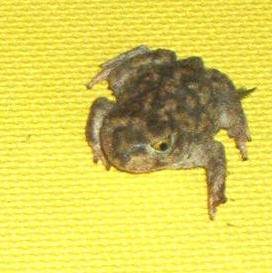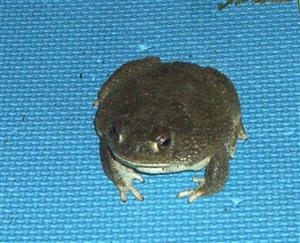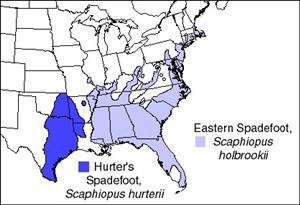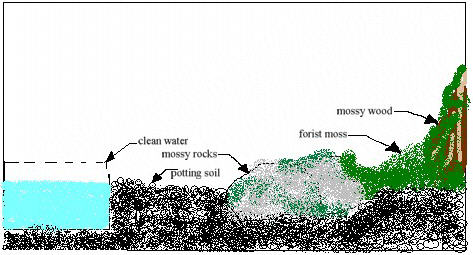

Spadefoot Toads
|
|
|
Eastern Spadefoot**************************** Hurterís Spadefoot

This is from the information I have researched on the two species of these cool and interesting amphibians. There are four species, including the plainís (Spea bombifrons) and the couchís (Scaphiopus couchii). Iíve never had these two so I did not add them to this sheet.
Only two will be addressed here. The Eastern Spadefoot (Scaphiopus holbrookii) and the Hurter's Spadefoot (Scaphiopus Holbrooki Hurterii )
The Eastern Spadefoot (Scaphiopus holbrookii)
Found east of the Mississippi River. The color is variable from shades of brown, gray, to almost black. They usually have a light yellow line that forms a crude hourglass shape on their back.
One of the most obvious characteristic of this toad is its eyes, which have vertical pupils (rather than horizontal ones as in all other eastern toads) and appear similar to a cat's eyes. As the name suggests, the Eastern Spadefoot Toad has a "spade" on each back foot to help it dig into the ground. Its body is smooth compared to bodies of other toads. This toad lives in sandy, often fairly dry habitats and spends the majority of its time buried in the soil.
When heavy rains in the spring and summer soak the soil and form temporary ponds, this triggers the emergence of large numbers of these toads from the ground. Mating and egg-laying take place quickly. Eggs are laid in the shallow, temporary pools; speed of development is variable and is related to the speed with which the pools shrink and dry up. Transformation from egg to tiny toad can occur within as little as two weeks. When growth and transformation are this rapid, the new adults are much smaller than normal.
The Hurter's Spadefoot (Scaphiopus Holbrooki Hurterii )
The color of the Hurter's Spadefoot TOAD varies from olive green to green-brown, or almost black. Two curved, light stripes are present on the dorsal surface. Its ventral surface is white or pale gray. This TOAD is also a stout one with a prominent boss between the eyes.
Again this toad has a "spade" on each back foot to help it dig into the ground. This toad lives in sandy, often fairly dry habitats and spends the majority of its time buried in the soil. When heavy rains in the spring and summer soak the soil and form temporary ponds, this triggers the emergence of large numbers of these toads from the ground. Mating and egg-laying take place quickly. Eggs are laid in the shallow, temporary pools; speed of development is variable and is related to the speed with which the pools shrink and dry up. Transformation from egg to tiny toad can occur within as little as two weeks. When growth and transformation are this rapid, the new adults are much smaller than normal.
Both of these Spadefoot Toadís are carnivorous and are opportunistic. They eat insects, earthworms, critics, maggots, millworms, waxworms, virtually any fishing bate you can purchase. It spends the majority of its time buried, emerging to feed at night or under very moist daytime conditions. Its preferred habitats are hardwood and mixed forests and coastal pine forests.
The Eastern Spadefoot Toad is found throughout the south eastern states, particularly where soils are loose and sandy. It is less abundant in northern states, than in the southern part of the states, primarily because of unfavorable soil conditions.
************************************************************************************************************************************************************************
IN CAPTIVITY
What has worked for us keeping these in captivity is a substrate of potting soil mixed with childrenís play sand, (potting soil with NO additives mixed with 25% sand), forest moss, and a rock or two, which allows the toad to find a variant in moisture. Keep a clean reservoir of water, soil mix, and a mossy area .
We only use spring water and bottled water (NEVER tap water). We spray the wet area twice daily, and clean the reservoir daily.
We keep them at room temperature aprox., 64 to 70 deg. F .
Never put in more feed insects in than they will eat. To many bugs crawling on the toad will stress them to DEATH.
Florescent UVA lighting such as for a fish aquarium or plant Vivarium, will aid in the moss growth and the ability of the toad to manufacture the minerals it needs to maintain a happy healthy life span.
These toads are very hardy if maintained in there proper conditions. The main thing is not to keep them to wet and never use tap water or chemically treated water. Also remember nobody likes to be kept in the dark all the time or to have there food crawl all over them.

Clean water reservoir is always spring or bottled water, changed daily as needed.
Potting soil has no additives other than childrenís play sand.
Rocks and moss and mossy wood we collect in the woods.
ThompsonsDEN.com CnAr1@yahoo.com
© Copyright 2005 ThompsonsDEN All Rights Reserved